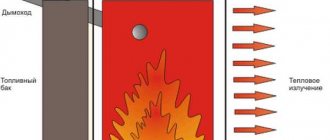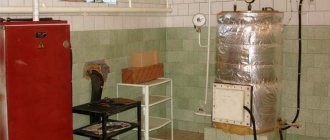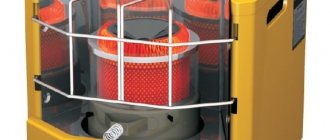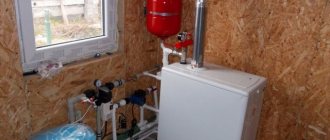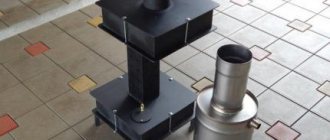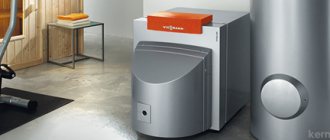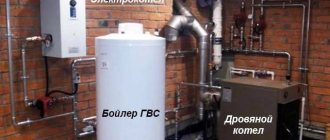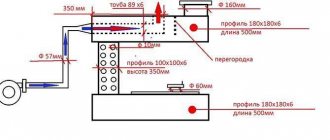A long-burning heating device - a pyrolysis furnace - is the optimal type of autonomous unit in conditions where there is no possibility of connecting to the main power supply lines. The installation is also called a gas generator, since the energy in it is generated as a result of afterburning gases that are released during the smoldering of solid fuel in the chamber. The pyrolysis unit is capable of uninterrupted operation on a single load of firewood or coal for a long period of time - from several hours to several days in a row - without constant monitoring.
Construction of pyrolysis furnaces
The design provides two compartments: the first contains solid fuel and the process of its slow oxidation occurs. When wood smolders, a large amount of flammable gases are released, which enter the compartment above and burn. To prevent the fuel from flaring up and smoldering, the supply of oxygen is strictly regulated. By and large, pyrolysis devices operate on gas, which is produced in the unit itself.
Scheme of a pyrolysis furnace
The operation of a long-burning installation provides the maximum amount of thermal energy with significant savings in fuel resources. This is due to the fact that the fuel is processed almost completely, as a result, soot and ash are almost not formed, and there is also no smoke.
Bubafonya stove - how the device works
This is the simple design of “Bubafonya”.
The Bubafonya stove is so simple to make that it can be made from an ordinary gas cylinder. Despite its simplicity, it is very effective and also undemanding on fuel. This pyrolysis oven works on sawdust, firewood, coal, pellets, tree bark, in general, on anything that burns. This design has been tested more than once and has shown its best performance. Principle of operation:
- Fuel is placed in the firebox and set on fire;
- a pressure circle is placed on top, to which the pipe is welded;
- there is a hole in the circle through which air is supplied;
- The firebox is closed on top with a lid. There is a hole in the lid for a pipe through which oxygen is supplied for combustion;
- the exhaust pipe for smoke is cut into the upper part of the firebox, just under the lid;
- As the fuel burns, the pressure circle and pipe are lowered.
There may be some inconvenience during operation. To add firewood or other solid fuel, you must first remove the lid, and then remove the pipe with the pressure circle. This can only be done when the temperature of the case has decreased so that it can be touched without getting burned. In addition, when you take out a moving part of the structure, and it is covered in soot, you can get dirty yourself and leave a mess around you.
Therefore, such wood-burning pyrolysis stoves are not used for residential buildings; these are mainly some kind of utility premises. The degree of afterburning of the fuel is so high that virtually no soot remains, and almost no smoke comes out of the chimney. The flame in such a stove burns from top to bottom. The denser the compounds, the better, since the pyrolysis reaction occurs in the absence or deficiency of oxygen. If air comes from all the cracks, the efficiency of the device will decrease significantly.
Pros and cons of gas generators
Pyrolysis combustion units are highly efficient and have many competitive advantages:
- high performance – efficiency up to 95%,
- environmental friendliness - minimal smoke level, no soot,
- comfortable maintenance - fuel is loaded 1-2 times a day depending on the model, there is no need to constantly monitor the fuel supply,
- fuel variability - pyrolysis can operate on any solid fuel resource. These can be various materials, including peat, pellets, wood, coal. Sawdust, husks, cardboard and other types of industrial waste are also used.
Another plus is the availability of self-assembly and installation of a factory model of a gas generator and the possibility of making a pyrolysis furnace with your own hands.
The main disadvantage of long-burning units is the high cost of the product. Depending on the power, models are sold in the range from 30 to 100 thousand rubles or more. Therefore, many are attracted to the idea of making their own pyrolysis oven for the home from inexpensive materials.
Among the disadvantages of operating pyrolysis devices, the requirements for fuel quality are also noted. Firewood must be stored in proper conditions to ensure optimal moisture levels. Otherwise, the efficiency of the unit is reduced, since the presence of wet vapors negatively affects the gas processing process.
Advantages and disadvantages of a pyrolysis furnace
This design has certain advantages over conventional ovens. These include:
- efficiency reaches 80%;
- fuel is consumed very economically;
- the ability to regulate the long-term combustion process;
- environmental friendliness. During operation, such a stove produces virtually no emissions of carcinogenic substances.
If a pyrolysis oven is made correctly, then its advantages are countless. For example, it has virtually no soot , which makes it easier to maintain cleanliness and spend a small amount of time cleaning the stove. And there are a lot of such small advantages.
However, the pyrolysis oven also has disadvantages:
- high price. It is more profitable to do it yourself;
- big sizes. If the room is not too large, it is better to use other heating structures;
- Such stoves are heated only with a certain type of fuel. Dry fuel (wood) is best suited because high humidity has a negative effect on the pyrolysis process;
- For its operation, a power supply is required, and a constant one at that. For best operation of the oven, it should be connected to an electrical network.
These are the main disadvantages of a pyrolysis oven. So you can safely operate such a stove if there is enough space for it, dry fuel is available and there is access to the electrical network.
Classification of pyrolysis devices
Gas generator furnaces are classified into several categories. Based on the material of manufacture, installations are distinguished between metal and brick. Models are also divided according to purpose and method of transferring thermal energy. According to the method of heat transfer, there are options for pyrolysis units with a water heating circuit and air system heat exchangers.
Metal pyrolysis combustion furnace
This group includes a number of designs:
- Potbelly stove. A gas generator with an internal structure in the form of a potbelly stove is used for heating residential and technical premises. The model is also relevant for baths and saunas, used for cooking, there are outdoor options for barbecue complexes,
- Buleryan stove. This shaft-type pyrolysis structure with an efficiency of up to 75% is intended for heating both residential and non-residential premises. Cold air is sucked in through the lower ends of the pipes surrounding the boiler, which quickly heats up and is thrown upward into the room through the upper elements.
- Bubafonya stove. The invention belongs to a craftsman from Kolyma; an old gas cylinder is used as the basis for the design. The installation is relevant for heating technical premises. A bubafonya from a cylinder with a volume of 50 liters is capable of working on one stack of firewood for 6 hours, maintaining a comfortable temperature in a room of up to 70 m².
- Lachinyan stove. The installation combines the highest possible efficiency and extremely low fuel consumption. The models are actively used for heating RVs and camping tents. “Lachinyanki” are also used for heating agricultural buildings and hunting lodges. Models with a water jacket are used for heating residential premises up to 300 m². It is noteworthy that 2 buckets of coal are enough for 5-7 days of uninterrupted operation of the pyrolysis unit of Lachinyan, a famous inventor from Kazakhstan.
- Pyrolysis furnace using waste oil. An economical long-burning unit during mining is designed for heating non-residential premises. The design is as simple as possible, and most home craftsmen can make such a model.
Pyrolysis furnace Buleryan
Long burning brick stove
A gas generator in the form of a brick structure - a Kuznetsov stove - is used for heating residential premises and bathhouse complexes. The device is also used for cooking. The efficiency of Kuznetsov pyrolysis furnaces is 80% and higher, the fuel in them burns almost completely. The full potential of hot gases and smoke is used to heat the brick body of the structure. High productivity of Kuznetsov gas generators is ensured by a special two-bell design.
How the oven works
Long-burning pyrolysis furnaces are designed according to a special principle. A combustion chamber with a burner is built into the body, where firewood is placed. The main condition for the combustion chamber is tightness. It is designed so that the air flow inside is minimal. The firebox must have a tight door and a reliable valve, and there must also be a supply and exhaust fan. After laying and igniting firewood, the combustion chamber is limited in the access of oxygen.
After the firewood has charred and released gas, it rises through a separate air duct into the second combustion chamber, where it is mixed in the required proportion with secondary air and burned. This process generates heat.
The second chamber, as a rule, is combined with an air duct or the beginning of a chimney. Air is provided by a supply and exhaust fan or a separate fan. If the chimney system is well thought out, then ordinary draft with sealed dampers will be sufficient.
Scheme and dimensions of the furnace
The body also provides a retort - a round part for extracting solid residues of burnt logs. A special feature of the pyrolysis furnace is that the fuel is burned almost completely, with only a small residue of ash, which is removed every few days.
Criterias of choice
If desired, it will be easy to choose a ready-made model whose parameters meet the requirements, but often home craftsmen, carried away by the ideas of inventors, make pyrolysis furnaces with their own hands. When choosing a gas generator installation option, a number of points are taken into account:
- purpose of the pyrolysis unit. To heat a barn, chicken coop, garage or other technical premises, choose a relatively compact metal or brick structure. To heat the house, the priority is to build a long-burning brick stove. For tourist purposes, choose a portable camping pyrolysis oven,
- device power. Depending on the parameters of the heated object, the required power of the gas generator is determined,
- mobility of the structure. The brick pyrolysis furnace is stationary; the device is erected at a permanent place of operation. Almost all types of metal gas generators are mobile.
For tourist purposes, choose a portable camping pyrolysis oven
For high-quality operation of a pyrolysis furnace, solid fuel of a certain humidity is required, reserves of which are stored in a utility room.
Buleryan stove - operating principle
The Buleryan stove comes from snowy Canada.
Buleryan stoves were invented in Canada. The climate there is as harsh as in Russia, so this device is perfect for our latitudes. How the Buleryan pyrolysis furnace works:
- fuel burns in the firebox (wood, coal, thyrsa, almost everything);
- in the upper, second chamber there are grate bars with air supply. There the released gas burns out;
- pipes are installed in the firebox through which air circulates;
- there is a chimney in the back.
The smoke does not interfere with the heated air in any way. Heating is carried out by convection. On one load, the stove can operate for up to 12 hours, depending on the size of the firebox. It can heat an entire house. In addition to the usual installation, you can add air ducts and distribute them to other rooms. This way, heating will happen faster and you won't have to open all the doors so that warm air can circulate throughout the house.
Buleryan stoves can be used both in the garage and in the country, or even in a small house where people live permanently. Since the air does not come into contact with the flame, the oxygen practically does not burn out, and the humidity remains the same. Such units are no longer new and are successfully used by many satisfied users.
Manufacturing of pyrolysis furnaces
When deciding how to make a pyrolysis oven with your own hands, you need to take into account the area and type of space to be served. The work is carried out on the basis of drawings, for the creation of which it is necessary to determine the dimensions and shape of the body, specify the type of location of the compartment for loading solid fuel and the gas afterburning chamber.
Materials and tools
To manufacture a metal pyrolysis combustion installation, you should collect the following set of auxiliary materials and tools:
- steel sheets 3-4 mm thick, grade St20,
- steel corners 50 mm – 4 pcs.,
- pipe d50,
- reinforcing elements,
- chimney pipes d120,
- bricks – 15 pcs,
- electric welding machine plus electrodes,
- electric drill, grinder,
- hammer, building level, tape measure, marker.
To manufacture a metal pyrolysis combustion installation, you should not forget about the grinder
When choosing materials for making a gas generator yourself, you should give preference to high-quality and reliable resources; the efficiency of the device and the safety of operation depend on this.
Drawings and calculations
You can make a drawing of the product yourself, using the image of the selected unit as a basis. Next, taking into account the features of the device, the required power is calculated. To do this, first determine the required power of the installation in the flame combustion mode, then calculate the parameters in the gas generation mode.
Next, calculate the volume of fuel that is necessary to provide the required power. To do this, calculate the mass of fuel, taking into account that the resource burns only 80%. It is worth remembering that the efficiency of a homemade pyrolysis center is on average 50%.
Finally, the volume of the furnace is calculated, taking into account that the load factor should not exceed the standard value for this industry of 0.63.
Selection and preparation of a site
When choosing a location for installing a stove structure, it should be taken into account that the space around any fireplace must meet fire safety requirements:
- the base platform is designed in the form of a platform with a flat surface made of non-combustible materials,
- the dimensions of the base must be larger than the parameters of the structure being built,
- a distance of at least 80 cm is maintained between the unit and the walls of the room,
- Wall surfaces are covered with heat-resistant facing materials.
To ensure safe operation, the floor surface of at least 1.2 m in front of the heating unit is reinforced with a non-flammable coating.
Manufacturing and installation
The work is performed in the following order:
- At the initial stage, the necessary blanks are made in the form of elements for vertical racks. Next, horizontal components are measured along the width of the installation, after which the frame parts are welded. When making walls, holes are made in the front panel for the firebox and ash pan, and they are equipped with fasteners for installing hinged doors. To install a grate and a tray with perforations separating the combustion chamber from the afterburning chamber, corners are attached to the inner surface.
- It is necessary to embed a blower with a damper into the side wall. To do this, a blower is prepared from a short section of pipe by drilling a hole for the damper axis. The valve axis is made from reinforcement, to which a steel disk is welded, the parameters of which correspond to the internal diameter of the blower.
- Starting from the bottom, the body parts are welded, then the grate with the partition element is laid. Then the lid is welded.
- An outlet with a rotation angle of 90° is welded into the hole in the cover to connect the housing to the chimney. A bur is connected to the outlet - a horizontal section 1 m long. It is needed in order to delay the release of gases from the afterburning chamber.
An example of making a pyrolysis oven with your own hands
The slide valve, which is installed at the end of the horizontal section, is made according to the same principle as the blower valve. But in this case, the diameter of the gate must be less than the internal diameter of the pipe, and a sector of ¼ of the base is cut out on the disk.
What is pyrolysis
The essence of pyrolysis is that at temperatures from 200 to 800 degrees (in conditions of lack of oxygen), gasification of wood occurs - it chars and smolders, gradually disintegrating into solid hydrocarbon (coke), resins and a mixture of non-condensable combustible gases. The pyrolysis gas released by the fuel can be burned separately from the solid residue, which makes it possible to obtain additional thermal energy. Using the unique properties of this process, it is possible to create a full-fledged heating device for heating a large house. Camping pyrolysis mini-ovens, which are assembled by tourists and outdoor enthusiasts with their own hands, work on the same principle.
This is a factory camping stove. Products of a similar design are assembled from tin cans and boxes
The actual heat of combustion of the released gaseous products can differ significantly (from approximately 3 to 15 MJ/m3); the calorific value of afterburning depends on the composition of the gas mixture. In turn, the composition of the pyrolysis gas is determined by the method of heat supply to heat the fuel, the speed and final temperature of the process. The percentage of solid and volatile components obtained will depend on these same conditions.
Note! During the combustion of the pyrolysis furnace, the solid residue (coal) burns in normal mode. Moreover, its calorific value is two and a half times higher than that of wood.
The most popular types of fuel for the furnace
Each type of combustible material has its own pros and cons. The choice of fuel depends on many factors: the design features of the stove, individual characteristics, affordability and availability in a particular region.
If a certain type of fuel is suitable for your stove, is inexpensive, but there may be interruptions in its supply, it should be discarded, especially in the cold season.
Firewood
The most common fuel for stoves is, of course, wood. In areas characterized by rich forest resources, they enjoy maximum popularity compared to any alternative fuel.
The main advantages of firewood:
- maximum availability;
- affordable cost;
- “predictability” in operation;
- long shelf life in a dry, ventilated area;
- absence of unpleasant odor from ash.
The calorific value of this combustible material differs slightly among different types of wood. For example, the densest and heaviest wood produces more heat. In terms of calorific value, birch is clearly the leader, but pine’s efficiency will be lower by at least 25%. Birch logs have only one drawback - when burned, they emit a lot of soot. In this case, you can put aspen or alder firewood last in the firebox, which leaves virtually no soot.
When choosing fuel for a wood-burning stove, it is advisable to avoid coniferous species because they contain a lot of resin. In addition, when burning, such firewood noticeably sparks and cracks a lot. Although this feature may be appropriate for a fireplace, the function of which is not only to heat the room, but also to create an atmosphere of home comfort, which is most facilitated by the cheerful crackling of logs.
The firewood in the stove creates an atmosphere of home comfort, which is greatly enhanced by the cheerful crackling of the logs.
Euro firewood or fuel briquettes
Another popular type of fuel for both conventional and long-burning stoves, as well as heating boilers and fireplaces, is the so-called Eurowood, or briquettes. They are made from wood waste. They differ in appearance, manufacturing technology, and service life.
The main advantages of fuel briquettes over conventional logs:
- increased burning time;
- high heat transfer;
- uniform combustion intensity;
- ash content no more than 1-3%;
- environmentally friendly with the release of a minimal amount of light, non-caustic smoke, practically odorless;
- ease of warehousing and storage.
The main disadvantages of Euro-firewood include relatively low heat transfer and the unpleasant smell of residues. This type of fuel is also characterized by the absence of the characteristic crackling and sparkling, which attract many lovers of relaxing by a classic fireplace.
Briquettes are made from wood waste. They differ in appearance, manufacturing technology, and service life.
Liquid heating oil
Liquid fuel for furnace combustion is obtained by distilling secondary diesel oil fractions. It is more viscous and heavier than diesel fuel, so it produces more heat when burned. High-quality liquid stove fuel contains no more than 0.02% ash, 0.5-1.1% sulfur and only traces of water.
Coal
There are three types of coal that can also be used as fuel for the furnace: brown, hard, anthracite. The latter is the most ancient of fossil coals and is considered its best grade, as it has the highest calorific value.
At the same time, it is believed that it is better to heat boilers with anthracite; it is ineffective as a fuel for stoves. Brown and hard coal with a combustion temperature reaching 1500 ° C are used to kindle stoves for heating private houses and fireplaces.
It is better to heat boilers with coal; it is ineffective as fuel for stoves.
Gas
Natural gas (methane) has a high calorific value, which reaches 8,500 kcal/m3. The advantages of this type of fuel also include high efficiency, relatively low price, almost universal availability, and the absence of soot on the walls of the stove and chimney during combustion.
The best option for a heating system is a universal stove that can operate on both wood and gas, provided that a special burner is installed.
Pellets
Small fuel granules - pellets - are produced in the same way as briquettes - by pressing waste from woodworking and other industries. This type of fuel is in demand for stoves of the appropriate design and boilers with automatic fuel loading.
In conventional stoves, pellets can also be used, but after a small modernization in the form of installing a pellet burner.
Fuel pellets are produced by pressing waste from woodworking and other industries.
A high-quality stove and efficient fuel will keep you from freezing in the cold and fill your home with warmth. The choice of both should be given special attention. In this case, a truly cozy atmosphere will reign in your home.
We use pyrolysis stoves to heat a house or bathhouse
One of the options for economical fuel consumption is the use of long-burning stoves or boilers. Using the same amount of fuel, they work much longer than other types of heating devices. Long-term combustion furnaces also include new pyrolysis furnaces.
The operation of these furnaces is based on the principle of the pyrolysis process - the thermal decomposition of any organic substances into pyrolysis combustible gases and solid residues. After this process, at high temperature, the resulting pyrolysis gas is mixed with oxygen. According to the laws of chemical reactions, this promotes almost complete combustion of both the gas itself and the fuel.
If at some stage you separate the solid residues from the composition, then, strangely enough, you get coke, and the equipment can be called a charcoal kiln. During heating, the main heating of the air is obtained due to the release of heat during the combustion of pyolysis gas mixed with air.
Advantages of pyrolysis ovens:
- High efficiency of the furnace. The fuel here burns more thoroughly, and much more heat is extracted from it.
- Environmental Safety. This is achieved due to the fact that very small amounts of harmful substances are present in the gases leaving the chimney.
- Fairly quick warm-up.
- High efficiency (up to 85%), which compares favorably with conventional boilers.
- Large power interval (thermal). This oven can operate at 5 and 100 percent of its capacity.
- Possibility of connecting any heating circuit to the device.
- Makes it possible to use various types of fuel (including raw firewood, tires and garbage.
- Requires minimal human participation in its work
The disadvantages include the rather large size, the presence of a site for fuel reserves, the presence of foreign odors when burning waste, the need for ventilation of the room, and the accumulation of condensate in the outlet channel and chimney.
